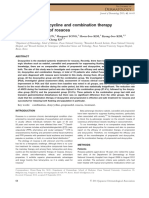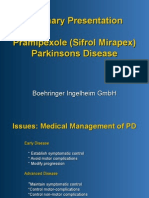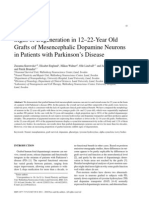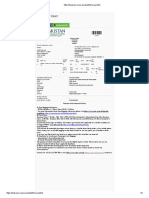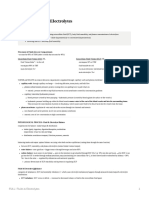Njiut
Njiut
Uploaded by
Prasetiyo WilliamCopyright:
Available Formats
Njiut
Njiut
Uploaded by
Prasetiyo WilliamOriginal Title
Copyright
Available Formats
Share this document
Did you find this document useful?
Is this content inappropriate?
Copyright:
Available Formats
Njiut
Njiut
Uploaded by
Prasetiyo WilliamCopyright:
Available Formats
Prof. dr.
Soebakrhag
Prof. Dr. Soebandrio SpPD KEMD
Prof DR dr R Dkokomeoljanto SpPD-KEMD teot
McElveen. 2012. NPH. Diakses dari: http://emedicine.medscape.com/article/1143066-
overview. 8. Djuanda, A dkk. Ilmu Penyakit Kulit dan kelamin : Penyakit Virus. Jakarta:
Fakultas Kedokteran Universitas Indonesia. 1993; (3): 94-95 9. Bowsher D. The lifetime
occurence of herpes zoster and prevalence of post-herpetic neuralgia: a retrospective survey
in an elderly population. Eur J Pain 1999;3:335-42 10. Dworkin RH, Portenoy RK. Proposed
classification of herpes zoster pain. Lancet 1994;343:1648. Robert Zorba Paster, The
Challenges of in the Long-Term Care Setting Postherpetic Neuralgia. Endo Pharmaceuticals.
2011;1:1. 12. Mario Roxas, ND. 2006. Herpes Zoster and NPH: Diagnosis and Therapeutic
Considerations. Alternative Medicine Review. 2006; 11:2 13. Jericho Barbara G. Postherpetic
Neuralgia: A Review. The Internet Journal of Orthopedic Surgery. 2010;16: 2. 14. Gharibo
Christopher, Kim Carolyn. Neuropatic Pain of Postherpetic Neuralgia. Pain Medicine News
Special Edition. 2010 15. Hopper AH, Brown RH. Adams and Victors Principles of
Neurology. 7th ed. New York, NY: McGraw Hill; 2005:797 16. Meliala L. Patofisiologi
Nyeri. Nyeri Neuropatik. Kelompok studi nyeri PERDOSSI 2008 ; 1-28 17. Meliala L. NPH.
Penuntun Penatalaksaan Nyeri Neuropatik. Kelompok studi nyeri PERDOSSI 2007 ; 59-60
Kdiuff
Priruhfjfn
http://www.youtube.com/watch?v=Vzs4_-gYNwk
hcjdjjdjdj
Prof Dr dr Suhartono SpPS
Betsoy scrotum crott
1484
May 18, 2000
The New England Journal of Medicine
A FIVE-YEAR STUDY OF THE INCIDENCE OF DYSKINESIA IN PATIENTS WITH
EARLY PARKINSONS DISEASE WHO WERE TREATED WITH ROPINIROLE
OR LEVODOPA
O
LIVIER
R
ASCOL
, M.D., P
H
.D., D
AVID
J. B
ROOKS
, M.D., D.S
C
., A
MOS
D. K
ORCZYN
, M.D., P
ETER
P. D
E
D
EYN
, M.D., P
H
.D.,
C
ARL
E. C
LARKE
, M.D.,
AND
A
NTHONY
E. L
ANG
, M.D.,
FOR
THE
056 S
TUDY
G
ROUP
*
A
BSTRACT
Background
There is debate about whether the
initial treatment for patients with Parkinsons disease
should be levodopa or a dopamine agonist.
Methods
In this prospective, randomized, double-
blind study, we compared the safety and efficacy of
the dopamine D2receptor agonist ropinirole with
that of levodopa over a period of five years in 268 pa-
tients with early Parkinsons disease. If symptoms
were not adequately controlled by the assigned study
medication, patients could receive supplementary
levodopa, administered in an open-label fashion. The
primary outcome measure was the occurrence of
dyskinesia.
Results
Eighty-five of the 179 patients in the ro-
pinirole group (47 percent) and 45 of the 89 patients
in the levodopa group (51 percent) completed all
five years of the study. In the ropinirole group, 29 of
the 85 patients (34 percent) received no levodopa
supplementation. The analysis of the time to dyski-
nesia showed a significant difference in favor of ro-
pinirole (hazard ratio for remaining free of dyskine-
sia, 2.82; 95 percent confidence interval, 1.78 to 4.44;
P<0.001). At five years, the cumulative incidence of
dyskinesia (excluding the three patients who had
dyskinesia at base line), regardless of levodopa sup-
plementation, was 20 percent (36 of 177 patients) in
the ropinirole group and 45 percent (40 of 88 pa-
tients) in the levodopa group. There was no signifi-
cant difference between the two groups in the mean
change in scores for activities of daily living among
those who completed the study. Adverse events led
to the early withdrawal from the study of 48 of 179
patients in the ropinirole group (27 percent) and 29
of 89 patients in the levodopa group (33 percent).
The mean (SD) daily doses given by the end of the
study were 16.56.6 mg of ropinirole (plus 427221
mg of levodopa in patients who received supple-
mentation) and 753398 mg of levodopa (including
supplements).
Conclusions
Early Parkinsons disease can be man-
aged successfully for up to five years with a reduced
risk of dyskinesia by initiating treatment with ropini-
role alone and supplementing it with levodopa if nec-
essary. (N Engl J Med 2000;342:1484-91.)
2000, Massachusetts Medical Society.
From the Clinical Investigation Center, Neuropharmacology Unit,
INSERM Unit 455, University Hospital, Toulouse, France (O.R.); the
Division of Neuroscience, Imperial College School of Medicine, Hammer-
smith Hospital, London (D.J.B.); the Department of Neurology, Tel Aviv
University Medical School, Ramat Aviv, Israel (A.D.K.); the Department
of Neurology, General Hospital Middelheim, Born-Bunge Foundation,
and University of Antwerp, Antwerp, Belgium (P.P.D.); the Department of
Neurology, University of Birmingham, Birmingham, United Kingdom
(C.E.C.); and the Department of Medicine (Neurology), University of To-
ronto and Toronto Western Hospital, Toronto (A.E.L.). Address reprint re-
quests to Dr. Rascol at the Service de Pharmacologie Medicale et Clinique,
Facult de Mdecine, 37 Alles Jules-Guesde, 31073 Toulouse CEDEX,
France, or at rascol@cict.fr.
*The investigators who participated in the study are listed in the Appendix.
LTHOUGH the antiparkinsonian effect of
the dopamine precursor levodopa was first
demonstrated 30 years ago,
1
and that of
dopamine D2receptor agonists more than
25 years ago,
2
the most appropriate time to begin
these two treatments in patients with Parkinsons dis-
ease remains controversial.
3
Some neurologists pro-
mote the early use of levodopa, emphasizing the rapid
symptomatic benefit
4
and the possible reduction in
mortality that the drug provides.
5
Others, more con-
cerned about the potential neurotoxicity
6
and the
long-term complications, such as dyskinesia, associ-
ated with the use of levodopa,
7-11
encourage the ear-
ly use of dopamine agonists. This long-standing con-
troversy remains largely unresolved,
12
although recent
data suggest that initiating treatment with a dopa-
mine agonist confers some advantage.
13,14
Data from
studies of monkeys treated with 1-methyl-4-phenyl-
1,2,3,6-tetrahydropyridine have demonstrated that
dopamine agonists are less likely than levodopa to
induce dyskinesia in animals that have not been ex-
posed to levodopa.
15
Because dyskinesia is one of the
most debilitating effects of levodopa therapy, we stud-
ied the incidence of dyskinesia associated with the
two treatments in a large, prospective, randomized,
five-year study.
Ropinirole is a nonergot-derived D2-like dopa-
mine-receptor agonist that is effective in the treat-
ment of early
14,16,17
and late
18,19
Parkinsons disease.
The effectiveness of ropinirole in the treatment of ear-
ly Parkinsons disease has already been demonstrated
through a planned interim analysis of the data from
the study described here, conducted six months after
the study was begun, in which the primary end point
was the score for motor function on the Unified Par-
kinsons Disease Rating Scale (UPDRS).
17
We present
here the results of the final five-year analysis, in which
A
The New England Journal of Medicine
Downloaded from nejm.org at THUERINGER UNIVERSITAETS-UND on November 19, 2012. For personal use only. No other uses without permission.
Copyright 2000 Massachusetts Medical Society. All rights reserved.
INCIDENCE OF DYSKINESIA AFTER ROPINIROLE OR LEVODOPA IN PATIENTS WITH EARLY PARKINSONS DISEASE
Volume 342 Number 20
1485
the primary outcome measure was the incidence of
dyskinesia.
METHODS
Study Population
A total of 268 patients were enrolled at 30 centers (in Europe,
Israel, and Canada). All patients were 30 years of age or older,
had a clinical diagnosis of Parkinsons disease
20
with a Hoehn
Yahr rating of stage 1 through 3 (with stage 1 indicating unilat-
eral, early disease and stage 3 more advanced, bilateral disease),
21
and required dopaminergic therapy. Prior short-term treatment
with levodopa or dopamine agonists was limited to a maximum
of six weeks and had to be discontinued at least two weeks before
entry into the study.
Patients were excluded if they had severe dizziness or fainting,
severe systemic disease, major psychosis, severe dementia, alco-
holism or drug dependence, or a contraindication to levodopa. In
addition, treatment with a monoamine oxidase inhibitor within
two weeks before entry (with the exception of selegiline) or pre-
vious treatment with ropinirole were reasons for exclusion.
Study Design
This prospective, randomized, double-blind study was designed
to compare the risk of dyskinesia in early Parkinsons disease among
patients treated with ropinirole (Requip, SmithKline Beecham,
Philadelphia) with that among patients treated with a combina-
tion of levodopa and benserazide (Madopa, HoffmannLaRoche,
Nutley, N.J.; referred to hereafter as levodopa) over a period of
five years. Random treatment assignment was performed with a
ropinirole-to-levodopa ratio of 2:1. Benserazide has been shown
previously to have properties that are similar to those of carbidopa
(used with levodopa in Sinemet [Dupont Merck, Wilmington,
Del.]) in blocking dopa decarboxylase in the periphery.
22,23
Blind-
ing of the study was maintained with the use of a double-dummy
technique. Sealed copies of the randomization code were held by
the principal investigator at each site and by the study sponsor.
Patients underwent a single-blind placebo run-in period lasting
seven days to demonstrate at least 80 percent compliance with
taking study medication. Patients were then randomized (with
stratification according to whether they were receiving concomi-
tant selegiline therapy), and assessments were performed at week-
ly intervals for the first month, every two weeks for the next two
months, every month up to six months, and every two months
thereafter.
The study was conducted in accordance with Good Clinical
Practices guidelines and the Declaration of Helsinki. The proto-
col was approved by an ethics committee at each center, and writ-
ten informed consent was obtained from each patient.
Treatment
Both ropinirole and levodopa were taken orally in tablet form.
The dose of study medication was adjusted weekly as required,
with 13 possible increasing dose levels. Ropinirole therapy was
initiated (dose level 1) at 0.75 mg per day (0.25 mg three times
daily) and levodopa therapy at 50 mg once daily plus placebo
twice daily. The maximal daily doses of study medication allowed
(dose level 13) were 24 mg of ropinirole per day (8 mg three
times daily) and 1200 mg of levodopa per day (400 mg three times
daily). Investigators were encouraged to treat patients only with
the assigned study medication. Patients whose symptoms were
not adequately controlled by the adjustment of study medication
alone (i.e., those with recurrent, persistent, or functional disabili-
ty), despite use of the highest tolerated dose, could be given sup-
plementary levodopa in open-label fashion. No other antiparkin-
sonian therapies were permitted after the start of the study.
Domperidone was permitted according to the normal practice at
each individual study center, to control severe dizziness, nausea, or
vomiting.
Clinical Assessments
Dyskinesia
Dyskinesia (the incidence of which was assessed in patients be-
fore withdrawal from the study or until completion of the study)
was considered to be present if a patient had a score of 1 or more
(on a scale from 0 to 4, where a score of 0 indicates no dyskinesia
and a score of 4 indicates dyskinesia during most waking hours)
on item 32 of the UPDRS
24
(Duration: what proportion of the
waking day are dyskinesias present?) or if dyskinesia was report-
ed as an adverse event. In addition, all reports of adverse events
consisting of abnormal movements considered to be dyskinesia
were reviewed before the randomization code was broken.
Additional Variables
Disabling dyskinesia was defined as a score of 1 or more on
items 32 and 33 of the UPDRS (How disabling are the dyski-
nesias?).
The scores for activities of daily living and motor function were
measured with the use of parts II and III of the UPDRS (items
5 through 17 [range of possible scores, 0 to 52, where 0 indicates
no disability and 52 indicates maximal impairment] and items 18
through 31 [range of possible scores, 0 to 108, where 0 indicates
no disability and 108 indicates maximal impairment]), respective-
ly, for the patients who completed the study.
Wearing off (defined as periods of increased severity of par-
kinsonian symptoms as medication wears off ) was assessed by re-
viewing the data from patients who reported increases in the du-
ration of time awake and in an off period on item 39 of the
UPDRS. Freezing when walking was assessed by reviewing re-
sponses to item 14 of the UPDRS.
Safety and Tolerability of the Drugs
Adverse events were assessed in a standard manner by the in-
vestigator. Neuropsychiatric adverse events (i.e., hallucinations, con-
fusion, d
elirium, psychosis, illusion, delusion, depersonalization,
personality disorder, abnormal thinking, amnesia, dementia, im-
paired concentration, and other related events, as defined by the
World Health Organization) were the only predetermined meas-
ures of safety in the statistical analyses.
Statistical Analysis
We planned to enroll 240 patients into the study (160 randomly
assigned to ropinirole and 80 to levodopa); this number was cal-
culated on the assumption of an underlying rate of response to
treatment of 85 percent. Samples of 110 patients in the ropinirole
group and 55 in the levodopa group who could be evaluated at the
six-month interim analysis
17
provided the study with an 80 percent
chance of demonstrating equivalent efficacy in the two groups
(with a 90 percent confidence interval), on the assumption that the
response rate in the levodopa group would not be more than 15
percent higher than that in the ropinirole group. It was anticipated
that 30 patients in the ropinirole group and 50 in the levodopa
group would complete all five years (predicted withdrawal rates, 30
percent and 10 percent per year, respectively). These numbers of
patients provided the study with 88 percent power to detect a dif-
ference (P<0.05) in the incidence of dyskinesia between the two
groups, assuming an incidence of 5 percent in the ropinirole group
and an incidence of 30 percent in the levodopa group.
All analyses (except those based on the scores for activities of
daily living and motor function) were performed on an intention-
to-treat basis and include all randomized patients who had at least
one assessment after receiving study medication. Patients were
not followed up for assessment of dyskinesia after withdrawal
from the study.
The rates of dyskinesia and disabling dyskinesia in the two
groups were compared with the use of the Cox proportional-haz-
ards model
25
in an analysis of failure time (time to an episode of
dyskinesia or disabling dyskinesia). KaplanMeier curves,
26
haz-
The New England Journal of Medicine
Downloaded from nejm.org at THUERINGER UNIVERSITAETS-UND on November 19, 2012. For personal use only. No other uses without permission.
Copyright 2000 Massachusetts Medical Society. All rights reserved.
You might also like
- Ecology of Shallow LakesDocument378 pagesEcology of Shallow LakesJheanNo ratings yet
- Sample WBS EPC ProjectDocument7 pagesSample WBS EPC ProjectNavneet Soni100% (2)
- PhET Collision LabDocument2 pagesPhET Collision Labcaleb f100% (1)
- MkioutDocument12 pagesMkioutPrasetiyo WilliamNo ratings yet
- MiutoDocument12 pagesMiutoPrasetiyo WilliamNo ratings yet
- NuitDocument12 pagesNuitPrasetiyo WilliamNo ratings yet
- Koiu MMDocument12 pagesKoiu MMPrasetiyo WilliamNo ratings yet
- MoiuDocument12 pagesMoiuPrasetiyo WilliamNo ratings yet
- OiutDocument11 pagesOiutPrasetiyo WilliamNo ratings yet
- Alpha-Dihydroergocryptine vs. Pramipexole As Adjunct Symptomatic Treatment of Idiopathic Parkinson'sDocument9 pagesAlpha-Dihydroergocryptine vs. Pramipexole As Adjunct Symptomatic Treatment of Idiopathic Parkinson'sRizka Leonita FahmyNo ratings yet
- Update On The Use of Pramipexole in The Treatment of Parkinson's DiseaseDocument16 pagesUpdate On The Use of Pramipexole in The Treatment of Parkinson's DiseaseDiego Marcelo Aragon CaqueoNo ratings yet
- Optimizing Levodopa Therapy When and How Perspectives On The Importance of Delivery and The Potential For An Early Combination ApproachDocument11 pagesOptimizing Levodopa Therapy When and How Perspectives On The Importance of Delivery and The Potential For An Early Combination ApproachTamilarasan.sNo ratings yet
- NDT 5190 Therapeutic Interventions and Adjustments in The Management 072910Document8 pagesNDT 5190 Therapeutic Interventions and Adjustments in The Management 072910MatejNo ratings yet
- 2024 - (LIXIPARK) - Trial of Lixisenatide in Early Parkinson's DiseaseDocument10 pages2024 - (LIXIPARK) - Trial of Lixisenatide in Early Parkinson's Diseasemanu.140295No ratings yet
- Drug Therapy For Parkinson's DiseaseDocument9 pagesDrug Therapy For Parkinson's DiseaseDireccion Medica EJENo ratings yet
- Ijohns 2015031219070250Document9 pagesIjohns 2015031219070250listyaNo ratings yet
- Pramipexole Vs Levodopa As Initial Treatment For Parkinson Disea 2004Document11 pagesPramipexole Vs Levodopa As Initial Treatment For Parkinson Disea 2004Dian GbligNo ratings yet
- Treatment ParkinsonDocument3 pagesTreatment ParkinsonElisabethNo ratings yet
- A Reassessment of Risks and Benefits of Dopamine Agonists in Parkinson's DiseaseDocument9 pagesA Reassessment of Risks and Benefits of Dopamine Agonists in Parkinson's DiseasePatel BrijeshkumarNo ratings yet
- JOURNALDocument10 pagesJOURNALTin NatividadNo ratings yet
- 1 s2.0 S2405650218300315 MainDocument6 pages1 s2.0 S2405650218300315 MainDian GbligNo ratings yet
- Jde 12687Document6 pagesJde 12687Ardina MiastutiNo ratings yet
- Complicatii LevodopaDocument5 pagesComplicatii LevodopaCarmen CiursaşNo ratings yet
- mishra2010Document6 pagesmishra2010Shubham ChauhanNo ratings yet
- Dexlansoprazole: A Proton Pump Inhibitor With A Dual Delayed-Release SystemDocument19 pagesDexlansoprazole: A Proton Pump Inhibitor With A Dual Delayed-Release SystemPham TrucNo ratings yet
- Pharmacokinetics of Levodopa/benserazide Versus Levodopa/ Carbidopa in Healthy Subjects and Patients With Parkinson's DiseaseDocument6 pagesPharmacokinetics of Levodopa/benserazide Versus Levodopa/ Carbidopa in Healthy Subjects and Patients With Parkinson's DiseaseWin StrikeNo ratings yet
- Summary Sifrol FarmakologiDocument38 pagesSummary Sifrol FarmakologiRadityaRezhaNo ratings yet
- Five Year Follow Up of Bilateral Stimulation of The Subthalamic Nucleus in Advanced Parkinson's DiseaseDocument10 pagesFive Year Follow Up of Bilateral Stimulation of The Subthalamic Nucleus in Advanced Parkinson's DiseaseRicardo GarciaNo ratings yet
- Comparison of Once-Daily Versus Twice-Daily Combination of Ropinirole Prolonged Release in Parkinson 'S DiseaseDocument7 pagesComparison of Once-Daily Versus Twice-Daily Combination of Ropinirole Prolonged Release in Parkinson 'S DiseaseAlfiatur RizkiNo ratings yet
- Cilia 2018Document1 pageCilia 2018Anna Beatriz Silva EspindolaNo ratings yet
- Treatment of Delirium With Quetiapine: One Personal Copy May Be PrintedDocument3 pagesTreatment of Delirium With Quetiapine: One Personal Copy May Be PrintedMahmoud WardNo ratings yet
- Radiotherapy With Hypoxic Radiosensitizer in Locally Advanced Head and Neck CancerDocument9 pagesRadiotherapy With Hypoxic Radiosensitizer in Locally Advanced Head and Neck CancerIJAR JOURNALNo ratings yet
- 2004 Linazasoro Farmacos No Utiles PDDocument12 pages2004 Linazasoro Farmacos No Utiles PDLucasUdovinNo ratings yet
- 142JMSDocument11 pages142JMSLianylin Calinao VargasNo ratings yet
- Journal ClubDocument63 pagesJournal Clubdrkadiyala2No ratings yet
- Initial Pharmacologic Treatment of Parkinson Disease - UpToDateDocument36 pagesInitial Pharmacologic Treatment of Parkinson Disease - UpToDateMaimuna MarshedNo ratings yet
- The Efficacy of Propofol and Midazolam in Treatment of Refractory Status Epilepticus in ChildrenDocument6 pagesThe Efficacy of Propofol and Midazolam in Treatment of Refractory Status Epilepticus in ChildrenReci MaulitaNo ratings yet
- Aripiprazol Discinecias Por LdopaDocument4 pagesAripiprazol Discinecias Por LdopaHercaiNo ratings yet
- Dupilumab Treatment in Adults With Moderate-to-Severe Atopic DermatitisDocument10 pagesDupilumab Treatment in Adults With Moderate-to-Severe Atopic DermatitisDwi Putri SimamoraNo ratings yet
- Jurnal Parkinson OniDocument5 pagesJurnal Parkinson OniMuhammad Agung SwasonoNo ratings yet
- Comment: Lancet Neurol 2020Document2 pagesComment: Lancet Neurol 2020dhea nadhiaNo ratings yet
- j.rs.20240902.11Document8 pagesj.rs.20240902.11Vero EmpuriaNo ratings yet
- Perioperative Medication Withholding in Patients With Parkinson's DiseaseDocument10 pagesPerioperative Medication Withholding in Patients With Parkinson's DiseaseMarli VitorinoNo ratings yet
- Brooks 2005Document6 pagesBrooks 2005JIAQI MagicNo ratings yet
- Long-Term Clinical Outcome of Fetal Cell Transplantation For Parkinson Disease Two Case ReportsDocument5 pagesLong-Term Clinical Outcome of Fetal Cell Transplantation For Parkinson Disease Two Case Reportsjust for download matterNo ratings yet
- Novel Pharmacological Targets For The Treatment of Parkinson's DiseaseDocument10 pagesNovel Pharmacological Targets For The Treatment of Parkinson's Disease2013_10_33_03_11_164No ratings yet
- Wearing Off ParkinsonDocument6 pagesWearing Off ParkinsonYunita Christiani BiyangNo ratings yet
- Jurnalparkinson 2Document10 pagesJurnalparkinson 2Vita SariNo ratings yet
- Ixazomib, Lenalidomide, and Dexamethasone PDFDocument14 pagesIxazomib, Lenalidomide, and Dexamethasone PDFJLNo ratings yet
- A Placebo-Controlled Trial of Oral Fingolimod in Relapsing Multiple SclerosisDocument15 pagesA Placebo-Controlled Trial of Oral Fingolimod in Relapsing Multiple SclerosisNidia BracamonteNo ratings yet
- 1305 FullDocument4 pages1305 FullBryan De HopeNo ratings yet
- 482 - Aripiprazole-Induced Tardive Dyskinesia in 13 Years Old Girl Successfully Treated With Biperiden A Case Report.Document3 pages482 - Aripiprazole-Induced Tardive Dyskinesia in 13 Years Old Girl Successfully Treated With Biperiden A Case Report.DivyeshNo ratings yet
- DyspepsiaDocument8 pagesDyspepsiaaspNo ratings yet
- Intestinal Levodopa/Carbidopa Infusion As A Therapeutic Option For Unresponsive Freezing of Gait After Deep Brain Stimulation in Parkinson's DiseaseDocument5 pagesIntestinal Levodopa/Carbidopa Infusion As A Therapeutic Option For Unresponsive Freezing of Gait After Deep Brain Stimulation in Parkinson's DiseaseBelén GonzálezNo ratings yet
- Bmjopen 2017 018148 PDFDocument7 pagesBmjopen 2017 018148 PDFEva AstriaNo ratings yet
- Parkinson Subtypes Progress Differently PDFDocument8 pagesParkinson Subtypes Progress Differently PDFParisNo ratings yet
- 60 - Minocycline Combination Therapy Withfluvoxaminein Moderate-To-Severe Obsessive-Compulsive Disorder, A Placebo-Controlled, Double-Blind, Randomized TrialDocument10 pages60 - Minocycline Combination Therapy Withfluvoxaminein Moderate-To-Severe Obsessive-Compulsive Disorder, A Placebo-Controlled, Double-Blind, Randomized TrialPaula CantalapiedraNo ratings yet
- The Effects of Aripiprazole On Electrocardiography in Children With PDDDocument7 pagesThe Effects of Aripiprazole On Electrocardiography in Children With PDDCarla MesquitaNo ratings yet
- WJPR Shivaleela Rev ArticleDocument26 pagesWJPR Shivaleela Rev ArticlerajeshNo ratings yet
- Controlled Trial Lansoprazole For Children With Poorly Controlled Asthma: A RandomizedDocument4 pagesControlled Trial Lansoprazole For Children With Poorly Controlled Asthma: A RandomizedJames HollandNo ratings yet
- New England Journal Medicine: The ofDocument9 pagesNew England Journal Medicine: The ofBobby S PromondoNo ratings yet
- The Prevention and Treatment of Disease with a Plant-Based Diet Volume 2: Evidence-based articles to guide the physicianFrom EverandThe Prevention and Treatment of Disease with a Plant-Based Diet Volume 2: Evidence-based articles to guide the physicianNo ratings yet
- OiutDocument11 pagesOiutPrasetiyo WilliamNo ratings yet
- P ('t':3) Var B Location Settimeout (Function (If (Typeof Window - Iframe 'Undefined') (B.href B.href ) ), 15000)Document2 pagesP ('t':3) Var B Location Settimeout (Function (If (Typeof Window - Iframe 'Undefined') (B.href B.href ) ), 15000)Prasetiyo WilliamNo ratings yet
- NXNX Kodk 0dod Fi9r98r 0r9r8rjf 89fjffj Ounfbbfnfv Oififi OepwiddnncmDocument6 pagesNXNX Kodk 0dod Fi9r98r 0r9r8rjf 89fjffj Ounfbbfnfv Oififi OepwiddnncmPrasetiyo WilliamNo ratings yet
- NXNX Kodk 0dod Fi9r98r 0r9r8rjf 89fjffj OunfbbfnfDocument6 pagesNXNX Kodk 0dod Fi9r98r 0r9r8rjf 89fjffj OunfbbfnfPrasetiyo WilliamNo ratings yet
- P ('t':3) Var B Location Settimeout (Function (If (Typeof Window - Iframe 'Undefined') (B.href B.href ) ), 15000)Document2 pagesP ('t':3) Var B Location Settimeout (Function (If (Typeof Window - Iframe 'Undefined') (B.href B.href ) ), 15000)Prasetiyo WilliamNo ratings yet
- !doctype HTML P ('t':3) Var B Location Settimeout (Function (If (Typeof Window - Iframe 'Undefined') (B.href B.href ) ), 15000)Document2 pages!doctype HTML P ('t':3) Var B Location Settimeout (Function (If (Typeof Window - Iframe 'Undefined') (B.href B.href ) ), 15000)Prasetiyo WilliamNo ratings yet
- BHBN P ('t':3) Var B Location Settimeout (Function (If (Typeof Window - Iframe 'Undefined') (B.href B.href ) ), 15000)Document2 pagesBHBN P ('t':3) Var B Location Settimeout (Function (If (Typeof Window - Iframe 'Undefined') (B.href B.href ) ), 15000)Prasetiyo WilliamNo ratings yet
- Kepl1359bel Oslon Square Osram Test Report413070Document9 pagesKepl1359bel Oslon Square Osram Test Report413070Akshay ThokeNo ratings yet
- 2018 ADB Annual ReportDocument116 pages2018 ADB Annual ReportFuaad DodooNo ratings yet
- UTM Installation and UTM Tasks ReportDocument20 pagesUTM Installation and UTM Tasks Reportdibash sigdelNo ratings yet
- E-Ticket PrintDocument3 pagesE-Ticket PrintImdad HussainNo ratings yet
- The French Revolution and NapoleonDocument8 pagesThe French Revolution and Napoleonfaisal sayyarNo ratings yet
- Fdocuments - in Otto Cycle PresentationDocument97 pagesFdocuments - in Otto Cycle PresentationUTSAV KUMARNo ratings yet
- Fluids and Electrolytes NotesDocument3 pagesFluids and Electrolytes Notesmichelle chenNo ratings yet
- Virtual Ground CircuitsDocument11 pagesVirtual Ground CircuitsRahul DevaNo ratings yet
- 2.winning and Working FMCC - SMCC - Opencast by MR - Deepak Vidyarthi 24.01.20...Document46 pages2.winning and Working FMCC - SMCC - Opencast by MR - Deepak Vidyarthi 24.01.20...Anurag DwivediNo ratings yet
- Chapter 7 and 8Document43 pagesChapter 7 and 8IamreeenNo ratings yet
- Unit 1Document49 pagesUnit 1jio325113No ratings yet
- Tatva Case Study 2020Document13 pagesTatva Case Study 2020ANKITA KESHARINo ratings yet
- Additional Reading MaterialDocument1 pageAdditional Reading MaterialLeo Angelu BabaelNo ratings yet
- Debug 1214Document4 pagesDebug 1214Muhammad IlhamsyahNo ratings yet
- Program SPCCTV 2019 CardiacSurgeryDocument8 pagesProgram SPCCTV 2019 CardiacSurgeryDu SantosNo ratings yet
- Introduction To Hematology 2Document39 pagesIntroduction To Hematology 2irishgopez24No ratings yet
- Enta100 GL BrochureDocument20 pagesEnta100 GL BrochureSurya Prakash Balakrishnan0% (1)
- Vinck - 1. PoglavljeDocument287 pagesVinck - 1. PoglavljeDubravka Sparožić100% (2)
- A Conversation With General Conference President Jan PaulsenDocument31 pagesA Conversation With General Conference President Jan Paulsenjester hudrNo ratings yet
- Ornamental PlantsDocument10 pagesOrnamental PlantsAntonio AngNo ratings yet
- Assignment On Recruitment Process: Subject: Nursing ManagementDocument12 pagesAssignment On Recruitment Process: Subject: Nursing Managementannu panchalNo ratings yet
- 211Document7 pages211Anonymous Qr763VNo ratings yet
- Developing The Research Proposal: A Case Study OnDocument14 pagesDeveloping The Research Proposal: A Case Study OnAruna MNo ratings yet
- US Army Physical Security ProgramDocument59 pagesUS Army Physical Security Programshakes21778No ratings yet
- Class 2 SmoDocument12 pagesClass 2 SmoNEELNo ratings yet
- China Steel Mark Scheme NewDocument5 pagesChina Steel Mark Scheme NewSahana RaoNo ratings yet
- Michael Burry's Approach To InvestingDocument47 pagesMichael Burry's Approach To InvestingMaxim Talon100% (2)





















